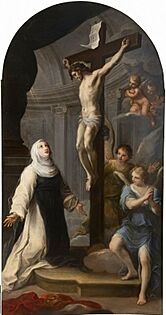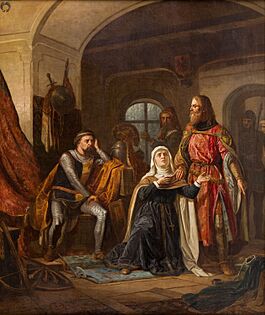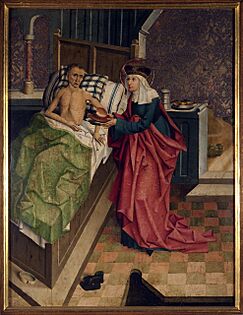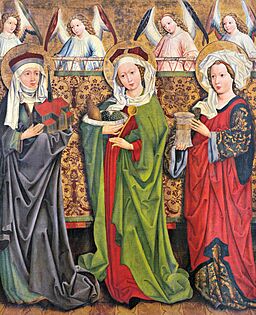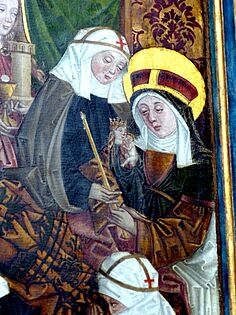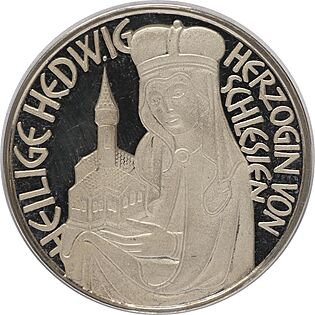Hedwig of Silesia facts for kids
Quick facts for kids SaintHedwig of Silesia |
|
|---|---|
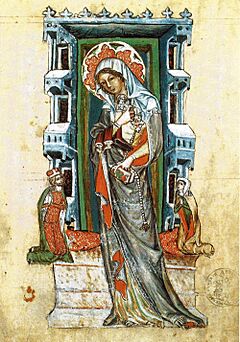
Saint Hedwig of Silesia with Duke Louis I of Brzeg and Duchess Agnés, Hedwig Codex, Lubin, 1353 (now in the J. Paul Getty Museum, California)
|
|
| Born | 1174 Andechs, Bavaria, Holy Roman Empire |
| Died | 15 October 1243 (aged 68–69) Trzebnica Abbey, Silesia, Kingdom of Poland |
| Venerated in | Catholic Church |
| Canonized | 26 March 1267 by Pope Clement IV |
| Major shrine | Andechs Abbey and St. Hedwig's Cathedral in Berlin |
| Feast | 16 October; moved to 20 October in Canada) |
| Attributes | wearing a church model or a pair of shoes in her hands |
| Patronage | Andechs Abbey, Brandenburg, Dioceses of Berlin and Görlitz, Kraków, Poland, Silesia, its capital Wrocław, Trzebnica, orphans |
Hedwig of Silesia (also known as Hedwig of Andechs) was a duchess and a saint. She was born in 1174 in Bavaria, part of the Holy Roman Empire. Hedwig became Duchess of Silesia and later Poland. She was known for her kindness and strong faith. The Catholic Church recognized her as a saint in 1267.
Contents
Her Early Life and Family
Hedwig was born into an important family called the House of Andechs. Her father was Count Berthold IV. She had many siblings. Her sister Agnes married King Philip II of France. Another sister, Gertrude, married King Andrew II of Hungary. Hedwig received her education at a Benedictine Abbey in Kitzingen.
Becoming a Duchess
When Hedwig was just twelve years old, she married Henry I the Bearded. He was the son of Duke Boleslaus the Tall of Silesia. In 1201, Henry became the Duke of Silesia. He faced many challenges from his relatives who also wanted power.
Hedwig often helped her husband. In 1229, Henry was captured by a rival duke, Konrad I. Hedwig bravely went to Konrad and convinced him to release her husband. Her actions helped Henry become a very powerful ruler. He became Duke of Greater Poland in 1231. The next year, he became the High Duke of Poland. This meant he was the most important ruler in the country.
Life as a Widow
Henry I the Bearded died in 1238. He was buried at Trzebnica Abbey, a monastery he had built at Hedwig's request. Hedwig was very sad but accepted his death with strong faith. She said, "Would you oppose the will of God? Our lives are His."
After Henry's death, Hedwig moved into the monastery. Her daughter Gertrude was the leader there. Hedwig lived as a lay sister, which meant she followed the rules of the monastery but did not take formal vows. She invited many German people to settle in Silesia. These settlers helped build new cities, towns, and farms.
Hedwig faced more sadness when her son, Henry II the Pious, was killed in battle in 1241. This happened during the Mongol invasion of Poland. Hedwig and her daughter-in-law, Anna of Bohemia, then built another monastery. It was for monks at the site of the battle.
Hedwig was very devoted to her faith and always helped others. She supported her husband in building churches and helping religious groups. She was especially kind to the poor, widows, and orphans. She founded hospitals for the sick. Legend says she walked barefoot even in winter. When a bishop told her to wear shoes, she carried them in her hands instead. Hedwig died on October 15, 1243. She was buried next to her husband at Trzebnica Abbey.
Becoming a Saint
Hedwig was made a saint in 1267 by Pope Clement IV. This happened because her grandson, Władysław, suggested it. She is the patroness saint of Silesia and other places like Andechs and Wrocław. Her feast day is celebrated on October 16.
In 1773, King Frederick the Great of Prussia built St. Hedwig's Cathedral in Berlin. He built it for Catholic people from Silesia who had moved there. Even today, many people remember and honor Saint Hedwig. In 2020, her remains, which had been missing for a long time, were found in her sanctuary in Trzebnica.
Special drinking glasses called Hedwig glasses are named after her.
Her Children
Hedwig and Henry I had seven children:
- Agnes (born around 1190)
- Bolesław (born around 1191)
- Henry II the Pious (born around 1196, died in battle in 1241)
- Konrad the Curly (born around 1198)
- Sophie (born around 1200)
- Gertrude (born around 1200), who became an Abbess
- A son (born before 1208)
Images for kids
Gallery
-
Legnica polyptych (reverse), depicting Saint Hedwig, Saint Elizabeth of Hungary and Saint Mary Magdalene
-
Dying Saint Hedwig looking at a statue of the Virgin Mary, Saint Catherine's church, Brandenburg an der Havel
See also
- Saint Hedwig of Silesia, patron saint archive







